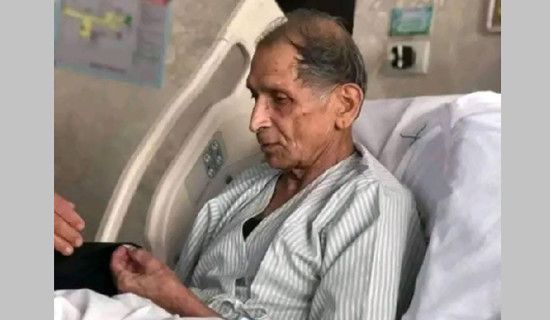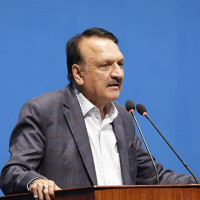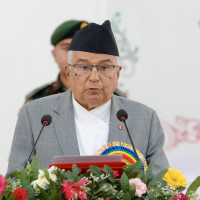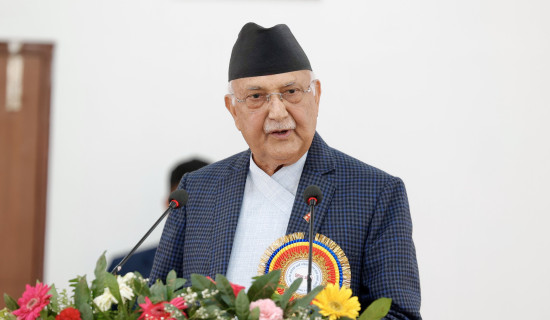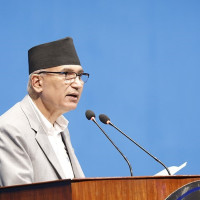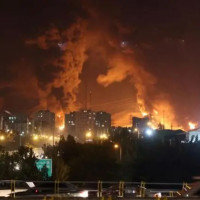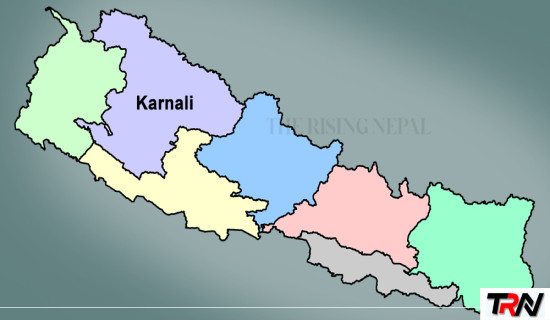- Sunday, 15 June 2025
From Ruins Of War, Vietnam Leaps Forward
When the itinerary for the tour was being finalised, we – Dr Giri Panthi and I – were very much keen to ensure that our list of must-see sites in Vietnam should include the sites and products that inform us, among others, about the country's history of war against America during the Cold War. My interest in rediscovering more about Vietnamese affairs from the real ground itself is ascribed to the news stories about the war in Vietnam that I came across when I worked for The Rising Nepal daily during the early eighties. The news about the Vietnamese refugees, termed as boat people, carried frequently by the news agencies like AP and AFP, used to make headlines in The Rising Nepal as well. Vietnamese boat people were refugees who fled Vietnam by boat and ship following the end of the Vietnam War after the fall of the government of South Vietnam, which led to the consolidation of the North and South into a unified nation. This out-migration was at its highest in the late 1970s and early 1980s but continued well into the early 1990s. The term is also often used to refer to the Vietnamese people who left their country in a mass exodus between 1975 and 1995.
Another news item that usually got splashed on the pages of The Rising Nepal in those days was the negotiation between the US and Vietnam to end the war. Le Duc Tho – the Vietnamese leader and close aide of Ho Chi Minh – was the key player in the peace negotiations. Le Duc Tho was known for his part in the ceasefire of 1973, when he served as special adviser to the North Vietnamese delegation to the Peace Conferences in Paris. He eventually became his delegation's principal spokesman. In that capacity, he negotiated with the famous US realist negotiator Dr Henry Kissinger, the US national security adviser, for ending the Vietnam War. He put his negotiation skills to broker peace with the US. The ceasefire agreement led to the withdrawal of the last American troops from South Vietnam. For this accomplishment, he was awarded the Nobel Peace Prize with Henry Kissinger as its co-winner. But he declined the Nobel Peace Prize. It was a coincidence that I had selected the news agency dispatch to carry this news as the desk editor and ensured that this news got proper highlight in Rising Nepal.
Thanks are due to the tour organisers, especially Sarita Twati from the Raintree Tours, for appreciating our interests and combining the places of natural, cultural, and political interests into our itinerary.
It was a very short visit to Hanoi – the capital city of Vietnam – as we had just four days to cover the planned tour schedules, including a fascinating Ha Long Bay cruise. Our guide for the Hanoi city tour was an intelligent young Vietnamese man, Maxie, who clearly understands the political history of Vietnam. He was eloquent enough to explain the details of the contemporary political and historical contexts. Hanoi is, indeed, a city of beautiful lakes. These lakes, as the city brochures say, were formed tens of thousands of years ago due to geological fluctuations of rivers that flow through the territory of Hanoi. We took a round tour of West Lake, which is said to be the largest natural lake in the city. It has a width of 500 hectares and a circumference of up to 18km. Our guide says West Lake has been a much sought-after relaxing place for locals and tourists.
Our guide took us to the holy Buddhist sanctum sanctorum called Tran Quoc Pagoda, where local Vietnamese and tourists prefer to pay a visit at dawn. We observed the Bodhi Briksha tree in the pagoda, which has outgrown and is conserved at the shrine complex as a sacred embodiment. The Bodhibriksha sapling was gifted to the Vietnamese leader Ho Chi Minh by the first president of the Republic of India, Dr Rajendra Prasad, when he visited the country during the fifties following India's independence.
Thereafter, we visited the Ho Chi Minh Mausoleum, which serves as a resting place for the late Vietnamese leader revered and respected as the father of the nation. I had a similar opportunity to visit the mausoleum of China's great helmsman, Mao Zedong, in Beijing a few years ago and had seen a big crowd of people lined up to pay respect to the late leader. In the case of the Ho Chi Minh mausoleum, one could witness the extensive lineup of both young and old, including the Vietnamese war veterans. A long queue of primary school kids waiting to pay homage to the late leader shows that the students from the early levels are made to socialise and familiarise themselves with their political and social history and national leadership.
It is a large building in the centre of Ba-Đình Square, where Ho Chi Minh read the Declaration of Independence in 1945, marking the end of French colonial rule and establishing the Democratic Republic of Vietnam. The mausoleum was formally inaugurated on August 29, 1975. According to sources, it was inspired by Lenin's Mausoleum in Moscow but incorporates distinct Vietnamese architectural elements, such as the sloping roof. The embalmed body of President Ho Chi Minh is preserved in the central hall of the mausoleum. The body lies in a glass case with dim lights.
After the visit to the mausoleum, we were led to visit the living and working place of President Ho Chi Minh's stilt house, which is exalted as a must-visit place for tourists upon visiting Hanoi. With a simple design wafting peaceful and fresh air at this place, visitors can learn more about the greatness and simplicity of Ho Chi Minh. He was affectionately known as "Uncle Ho", who had passed away on September 2, 1969, four years before the Paris Peace Accords were signed for formalising the US retreat from Vietnam, six years before the country was finally liberated and seven years before the Socialist Republic of Vietnam would officially come into being. Ho Chi Minh is a figure credited with the victory of the Vietnamese people in the war. He was an extremely popular figure in Vietnam even before the Vietnam War.
According to the sources, when the US decided to ignore the Geneva agreements of 1954 on holding an election in Vietnam, US President Dwight Eisenhower stated in his memoir that elections could not have happened because if they did, Ho Chi Minh and the communists would win by an overwhelming majority.
More than two decades of the Vietnam War had inflicted a devastating toll on Vietnam's population. According to the relevant sources, an estimated 2 million Vietnamese were killed, while 3 million were wounded, and another 12 million became refugees. Warfare had demolished the country's infrastructure and economy. In the United States, the effects of the Vietnam War lingered long after the last troops returned home in 1973.
The nation spent more than $120 billion on the conflict in Vietnam from 1965 to 73. This massive spending led to widespread inflation, exacerbated by a worldwide oil crisis in 1973 and skyrocketing fuel prices. The later years of the war saw increased physical and psychological deterioration among American soldiers—both volunteers and draftees—including drug use, post-traumatic stress disorder, mutinies, and attacks by soldiers against officers and noncommissioned officers, say reports.
Bombarded by horrific images of the war on their televisions, Americans turned against the war as well. In October 1967, some 35,000 demonstrators had staged a massive Vietnam War protest outside the Pentagon. Opponents of the war argued that civilians, not enemy combatants, were the primary victims and that the United States was supporting a corrupt regime in Saigon. The war weakened the myth of American invincibility. It had bitterly divided the nation. Many returning veterans faced adverse reactions. The opponents of the war viewed them as having killed innocent civilians.
The supporters of war saw them as having lost the war. The physical damage wrought upon the infrastructure by the war was horrendous. The effects of exposure to the toxic herbicide Agent Orange dumped by US planes on the dense forests of Vietnam were terrible. In 1982, the Vietnam Veterans Memorial was unveiled in Washington, D.C. On it were inscribed the names of 57,939 American men and women killed or missing in the war, say the reports.
In 1976, Vietnam was unified as the Socialist Republic of Vietnam. However, sporadic violence continued over the next 15 years, including conflicts with neighbouring China and Cambodia. Although a Communist Party government leads Vietnam, it has adopted a broad free market policy. As a result, the economy began to improve, boosted by oil export revenues and an influx of foreign capital. Trade and diplomatic relations between Vietnam and the US were resumed in the 1990s.
Included in our itinerary in Hanoi was Hỏa Lò Prison, which was initially used by the French colonists in Indochina for political prisoners. Later, according to our guide, this facility was used by North Vietnam for US prisoners of war during the Vietnam War. It was known to American POWs as the "Hanoi Hilton" during this later period.
The French built the prison in Hanoi when Vietnam was still part of French Indochina. The French called the prison Maison Centrale, or 'Central House, which is still the designation of prisons for dangerous or long-sentence detainees in France.
It was intended to hold Vietnamese prisoners, particularly political prisoners agitating for independence, who were often subject to torture and execution. Following the defeat at the Battle of Dien Bien Phu and the 1954 Geneva Accords, the French left Hanoi, and the prison came under the authority of the North Vietnamese government.
Beginning in early 1967, a new area of the prison was opened for incoming American prisoners of war. Regarding the treatment of detainees at Hỏa Lò and other jails, our guide told us that prisoners were treated well and by the Geneva Conventions. The North Vietnamese prisons were claimed to be no worse than prisons for POWs and political prisoners in South Vietnam. However, some independent reports contend that mistreatment of Viet Cong and North Vietnamese prisoners and South Vietnamese dissidents in South Vietnam's prisons was indeed frequent, as was North Vietnamese abuse of South Vietnamese prisoners and their dissidents.
A tourist of today would be surprised that just 50 years ago, this country was a place that had been bombed into rubble. Moreover, 45 per cent of rice fields were destroyed, and half of all forests were decimated. While Vietnam has many issues to face up to and confront today, no one can deny its tremendous transformation into the prosperous country it is today in fifty years since it emerged out of the colonial yoke, war, and subjugation.
(The author is presently associated with the Policy Research Institute (PRI) as a senior research fellow. rijalmukti@gmail.com)



